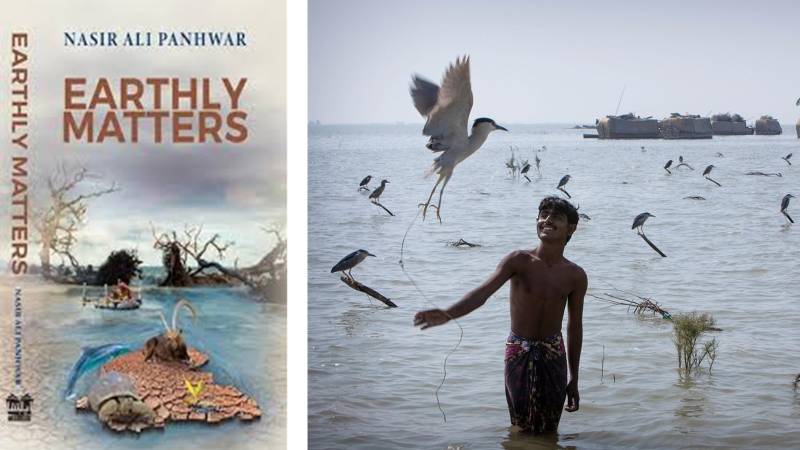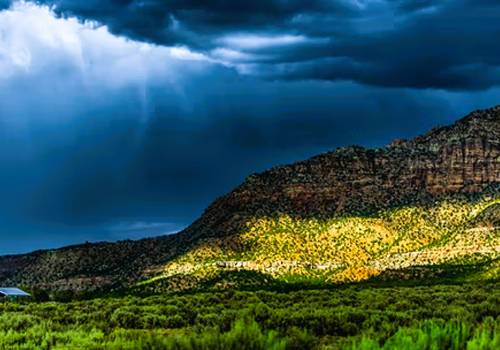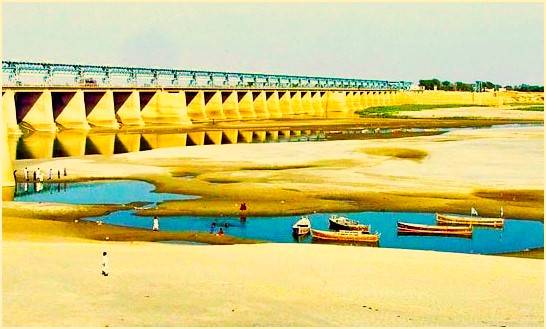
Nasir Panhwar is among the few professionals who have dedicated themselves to writing about environmental and ecological issues in Sindh. His work reminds me of an inspiring biographical book, The Forest Man: The True Story of Jadav Payeng. The book shows how a young man single-handedly transformed a barren land into a thriving forest. Similarly, Panhwar’s regular writings on Sindh’s forests, rivers, lakes, and coasts have made a significant impact at the policy level, sparking crucial debates.
In his latest book Earthy Matters, Panhwar has presented a comprehensive exploration of Sindh’s environmental landscape, covering a range of thematic sections, including biodiversity, climate change, coastal ecosystems, the Indus delta, disasters, drylands, energy and urbanisation, rivers, sustainable development, water and wetlands, and rural development/agriculture.
The book's opening section on biodiversity offers a wealth of practical solutions. One standout article, Saving Karoonjhar, examines the historical and cultural significance of the Karoonjhar Hills, a home to unique geological formations and rare wildlife species. He laments the threats posed by illegal mining and deforestation, which have damaged the environment and endangered many species. He passionately appeals for the designation of Karoonjhar as a national park, with the necessary resources and a comprehensive management plan. In another equally important piece, A Forgotten Tree, the author show us the environmental and public health challenges that are plaguing Sindh, tracing them back to a drastic reduction in green cover due to rapid urbanisation and deforestation. He advocates for the planting of the indigenous Neem tree, which is drought-resistant, medicinal, and useful for construction and fuel, as a crucial strategy to mitigate these pressing issues. Another article worth commenting on is Biodiversity for food security. He explains how biodiversity is crucial for agriculture and food production, but is threatened by human activities. A diverse array of plants, animals, and ecosystems is needed to ensure food security and sustainability. He has chalked out how farmers could play a vital role as stewards of biodiversity, using sustainable practices.

The author has gathered together a set of twelve articles under the “Climate change” section. A majority of articles are embedded in environmental realities. One such article is Ecological consequences of coal exploitation. Here the author has systematically established that coal is a major contributor to greenhouse gas emissions, responsible for 44% of energy-related CO2 emissions globally. He has explained how coal mining and its use severely impact the environment, destroying landscapes, disrupting hydrology, and acidifying groundwater. He has elaborated that the carbon footprint of coal is further increased by methane emissions from mines and transportation. He has suggested that reducing coal consumption is essential to mitigate climate change and environmental damage.
Title: Earthy Matters
Author: Nasir Ali Panhwar
Publishers: Elsa Publication, Hyderabad
Year: 2023
Price: Rs 1,000/-
The third section deals with the “Ecosystem and Indus delta.” The section contains five articles. However, Survival of the Indus delta stands out for me to elaborate upon it. The article states that the Indus Delta is facing a severe crisis due to the lack of freshwater flow from the Indus River. The situation has caused a massive migration and increased poverty, malnutrition, and health problems in the affected areas. The article argues that the economic value of the ecosystem's freshwater needs has been marginalised in water allocation decisions, leading to conflicts between different uses and users. Other articles in the section are about securing environmental flows for Indus delta, ensuring water to the Indus delta, caring for the oceans and seas and Zulfikarabad or Indus delta revival. In the last article, the author has vaguely proved how a new settlement would revive the Indus delta.
The fourth section explores “Disasters” and presents ten articles. These articles could be arranged into three-sub categories of disasters, floods and responses. Their focus remain is on Pakistan’s experiences with major flood events and the challenges in disaster preparedness, response, and recovery efforts. The author suggests a focus on documenting and analysing Pakistan's experiences with natural disasters, particularly droughts and floods, and approaches to disaster management and mitigation. In this section, the article Tackling drought shows how arid zones of Sindh are prone to severe and prolonged dry spells. The article pinpoints the reasons such as weather patterns, reduced rainfall, overexploitation of water resources, and a general impact of climate change. The author has also suggested some interventions: water management, conservation and other measures that affect agriculture.
A fifth section of the book is “Dry lands.” There are three articles here: Tackling drought in Sindh, The encroaching deserts and desertification, and Drought menaces. These articles summarise as to how Sindh is facing a formidable challenge due to desertification. This crisis demands a comprehensive response that addresses the underlying causes and empowers local communities to build resilience. The author suggests that leveraging scientific knowledge, traditional wisdom, and collaborative efforts can help Sindh overcome the menace of encroaching deserts.

The sixth section is about “Energy and urbanisation.” It contains four articles. Among them, Invisible cost of road accidents demands some elaboration. The author has cited a considerable number of cases and their particular points of occurrence, one of which is the Jamshoro-Sehwan Sharif section of the Indus Highway. He has established how road traffic injuries are a leading cause of death globally, particularly among the young.
Let us congratulate Nasir Panhwar for his important contribution that has underscored the link between climate change and economic prosperity in Sindh
A seventh section in the book is about “Rivers.” There are seven articles in this section but the article titled Rivers in Crisis needs our particular consideration. The author explains that rivers are facing challenges due to pollution, dams, and over-extraction. He has noted that two-thirds of rivers are harmed by 50,000 large dams, with many no longer reaching the ocean. Additionally, the article suggests that healthy rivers provide critical ecosystem services like water, food, and flood regulation, but these are threatened by over-extraction, diversions, and climate change. The article also pinpoints that dams are the most significant modifier of natural river flows, heavily altering regimes and fragmenting ecosystems. In this regard, he has quoted the Indus River's problems, with reduced flow degrading the delta, harming mangroves, fisheries, and agriculture. Climate change will further exacerbate the river crisis unless mitigative action is taken. Other articles in this section are Flowing Rivers are the Lifeline of the Planet, The Future of Sukkur Barrage, Managing River Basins for Wetlands, and Rivers’ Support Services to the Economy.
We see that the maximum number of articles is presented under section eight, titled “Sustainable Development.” This section presents 21 articles, all of which are important. The first article, Harnessing the Tourism Potential of Sindh, discusses the relevance and proposes ideas on how tourism could be turned into a business activity. The article sets the context, noting that Sindh has a wealth of historical, cultural, and natural attractions that could drive significant tourism growth, yet the industry remains largely underdeveloped compared to the country's northern regions. Sindh boasts a diverse array of assets, from the archaeological remains of the Indus Valley civilisation to the magnificent shrines of revered Sufi saints, imposing historic forts and palaces, lush riverine forests, and stunning desert landscapes. However, the article also points out that many of Sindh's valuable wetlands have become degraded in recent years due to unsustainable exploitation, industrial pollution, and drought. These wetlands offer immense ecotourism potential if properly developed and managed. The article suggests that the provincial government must make tourism development a priority, completing long-delayed infrastructure projects, regulating existing tourism operators, and reactivating the Sindh Tourism Development Corporation.
The ninth section is titled “Water and Wetlands” and contains ten articles. The article Wetlands: A Natural Solution for Climate Change is an important one and states that wetlands help to stabilise greenhouse gas emissions and reduce the impacts of climate change. However, ongoing climate change is projected to severely impact wetlands, reducing surface and groundwater resources, increasing extinction risk for freshwater species, and damaging coastal ecosystems through sea level rise. While increased demand for hydropower and biofuels can cause wetland loss, the carbon sequestration function of wetlands can also promote their conservation and restoration. The article argues that effective governance at all levels is crucial for preventing, stopping, and reversing wetland degradation. Integrating wetlands into policy frameworks like the Sustainable Development Goals can help achieve their wise use and conservation. The article also emphasises the importance of capacity building and diverse stakeholder involvement for successful wetland management. Fully integrating the ecosystem services and values of wetlands into economic decision-making remains an ongoing challenge, and addressing the drivers of wetland loss and degradation requires a holistic, multi-faceted approach.
The final section is titled “Rural Development and Agriculture.” This section has four articles, all of which are relevant and important. The article Promoting Food Safety elaborates on the issue of Sindh's standing crops facing increasing pest and disease damage despite control measures. The reasons include pesticide resistance, climate change, and depletion of soil minerals. The article particularly highlights the issue of fruit trees being affected, leading to increased pesticide use, which poses a serious health risk to consumers and agricultural workers. The article suggests that alternative methods, such as Integrated Pest Management (IPM), are available but underutilised. Promoting IPM could not only improve food safety but also enable access to high-end markets for Pakistani produce, both locally and for export.
Sindh’s environmental landscape is characterised by a diverse array of ecosystems, from the majestic Indus delta and coastal regions to the vast drylands and rivers that sustain the country. However, the author has warned that these precious natural resources face multifaceted challenges that require a comprehensive and integrated approach to ensure sustainable development. As such, the articles in this book have persuasively argued that climate change has emerged as a significant threat, impacting biodiversity, exacerbating natural disasters, and disrupting the delicate balance of coastal and riverine systems. The author has reminded the concerned quarters that environmental issues require tailored strategies to enhance resilience, promote sustainable agriculture, and combat desertification.
This book offers a set of valuable recommendations, emphasising that sustainable development requires a holistic approach that balances economic growth, social well-being, and environmental protection, through aligned policies, multi-stakeholder collaboration, and empowered local communities. Therefore, let us congratulate Nasir Panhwar for his important contribution that has underscored the link between climate change and economic prosperity in Sindh. The book is a crucial resource for anyone seeking to understand and address the multifaceted issues confronting Sindh’s sustainable future.

